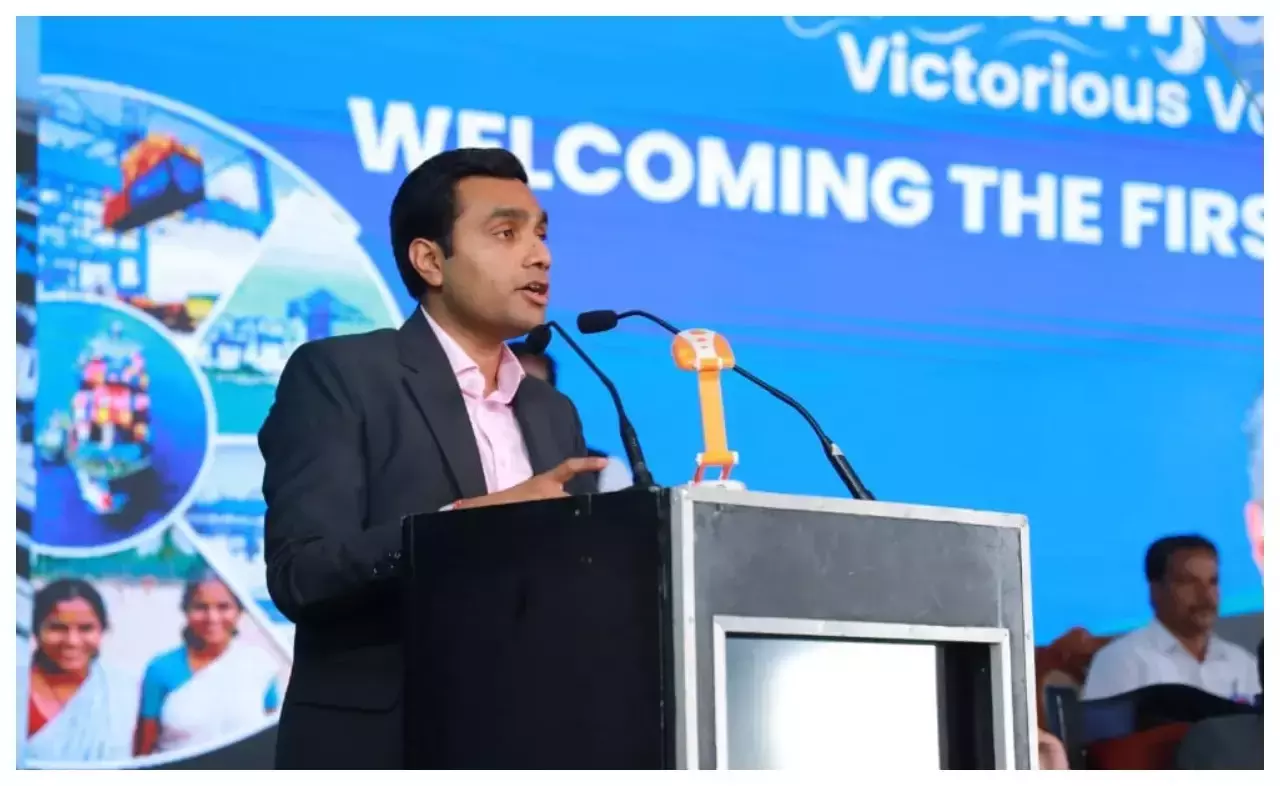TRENDING TAGS :
Vizhinjam Port: A Triveni Confluence of Technology, Power, and Trade
Discover the historic Vizhinjam International Seaport, inaugurated by PM Narendra Modi, as it transforms India’s maritime trade, power, and global logistics influence through cutting-edge technology and strategic significance.
Vizhinjam Port (PC- Social Media)
The quiet yet strategically crucial town of Vizhinjam, located on the coast of Kerala, is now ready to shine on the global maritime map. Inaugurated by Prime Minister Narendra Modi on May 2, 2025, the Vizhinjam International Seaport marks a historic step that will redefine India’s maritime power. This port not only enhances India’s trade capabilities but also elevates its strategic and technological stature to global standards. Let us explore the key features and historical journey of this landmark project:
History and Background: The Origin of Vizhinjam Port
The concept of the Vizhinjam International Seaport is not a recent development—it traces back to the 19th century. The rulers of Travancore and British colonial administrators had identified this coastal region as a potential port due to its natural depth and favorable geographic location. However, due to political and technological limitations at the time, the idea never materialized.
In the 1950s, both the Government of India and the Kerala state government revisited this location, but the lack of economic resources and strategic priority once again shelved the plan.
With the onset of globalization in the 1990s and 2000s, and India’s expanding maritime trade, the relevance of this site resurfaced. In 2003, the Kerala government formally initiated plans to revive the port project. Several global tenders were invited in phases, but due to reasons like environmental approvals, investment uncertainties, and local resistance, the project kept facing delays.
In 2015, Adani Ports and Special Economic Zone Limited (APSEZ) was entrusted with the development of the project. Since then, the plan has advanced rapidly. The vision for this port stemmed from the fact that Vizhinjam offers the nearest deep-water coastline in the Indian subcontinent, where massive container vessels can anchor without the need for dredging. This makes it a viable alternative to transshipment hubs like Colombo, Singapore, and Dubai, thereby reducing India’s dependence on foreign ports. The port also holds strategic importance for India’s maritime security and control over international logistics. The historical journey of the Vizhinjam project reflects how a decades-old dream has now become a symbol of India’s maritime self-reliance.
Key Features of the Project
1. A Vision for a Multipurpose Maritime Hub
Vizhinjam Port is primarily designed for container transshipment but is also fully equipped to handle break-bulk and other commercial cargo operations. Its goal is to establish India as a global maritime logistics hub.
2. Strategically Located Close to Global Shipping Routes
The port is located just 10 nautical miles from some of the busiest international sea routes, connecting Europe, the Gulf countries, and the Far East. This geographic advantage gives Vizhinjam the potential to become a major global transshipment hub.
3. Integration of Advanced Design and Automated Technologies
Built on modern technology, Vizhinjam Port boasts a natural depth of approximately 20 meters, allowing the world’s largest container vessels to dock with ease. Equipped with pre-cast structures, automated container handling systems, high-capacity gantry cranes, and advanced tracking technology, the port is a model of technical excellence.
4. A Role Model of Public-Private Partnership
The project has been developed by Adani Ports and SEZ Ltd., India’s largest port developer, in collaboration with the Government of Kerala. The state government has borne two-thirds of the total cost, making it a notable example of successful public-private cooperation.
5. Cost, Construction Timeline, and Investment
The estimated total cost of Vizhinjam Port is ₹8,867 crore. Initiated in 2015, the project took about 10 years to complete, facing multiple technical and social challenges due to the COVID-19 pandemic and environmental approvals. Despite this, it was completed on schedule, reflecting strong planning and commitment.
6. Pillar of Local Employment and Social Reconstruction
The construction and operations of the port have provided direct and indirect employment to thousands of people. Special training and development programs have been implemented for local fishing communities, youth, and women, leading to significant socio-economic empowerment.
7. Commencement of Testing and Commercial Operations
Following successful trials on December 4, 2024, the port received certification for commercial operations. It is now fully ready to compete with any major port in the world.
8. Environmentally Conscious and Sustainable Development
Environmental impact was a top priority during planning and execution. Protection of marine ecology, coastal biodiversity, and the livelihoods of fishing communities were central concerns, enabling the port to be recognized as a “Green Port.”
9. Strategic Power and Geopolitical Significance
Against the backdrop of Sri Lanka’s Hambantota Port, Vizhinjam emerges as a strategic alternative. It enhances India’s maritime security and trade sovereignty while strengthening its position in the Indo-Pacific region.
10. Future Plans and Vast Expansion Potential
With the completion of Phase I, future phases include the addition of container terminals, a multimodal logistics hub, railway connectivity, and township development. The port is on its way to becoming South India’s most powerful maritime center.
A New Dimension to India’s Maritime Power
The Vizhinjam International Seaport is not just an infrastructure project—it is a symbol of India’s maritime pride and economic self-reliance. With the potential to transform Kerala and the nation into a global trade hub, the port serves as a gateway to economic growth and a cornerstone of India’s future maritime strategy.


